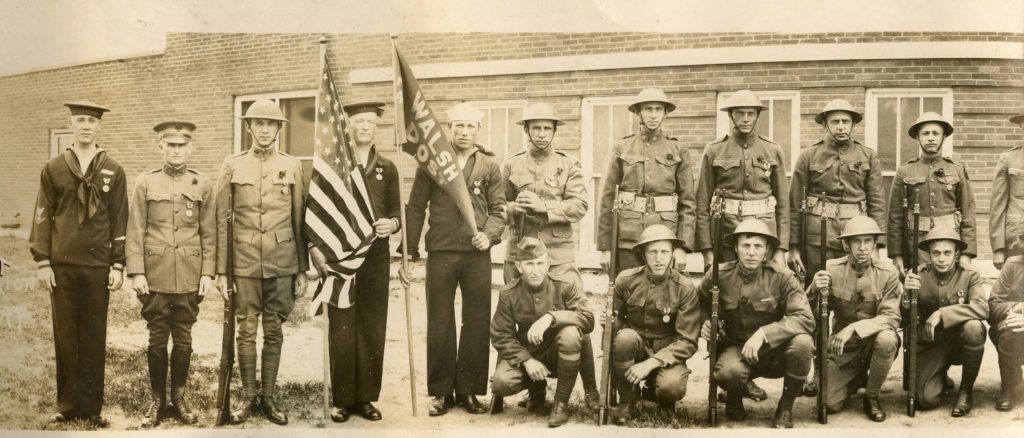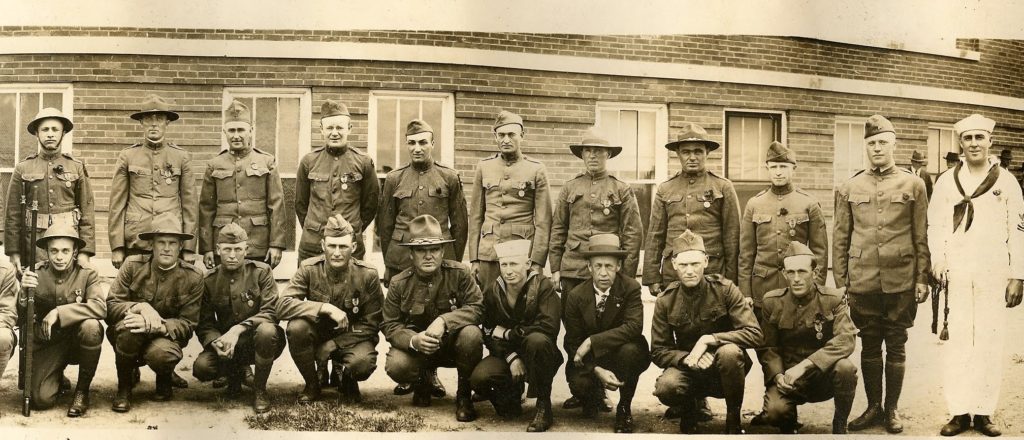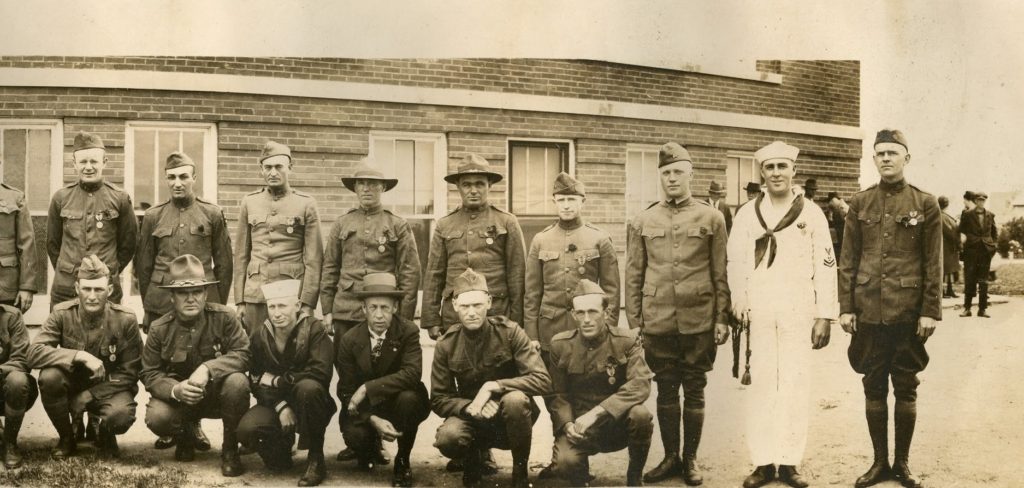World War I; 1917-19
Walsh Post 432 is under construction. Please visit us often for updated content.
“Under the direction of Governor William L. Harding, Commander in Chief, Iowa sent into the Federal Service during the war with the Central powers, 1917-1919, about 98,000 soldiers; 10,000 sailors and 600 Marines; all of whom accredited themselves honorably, reflecting luster upon the state.
The 98,000 soldiers comprised 9,717 National Guardsmen; 68,512 selected service men; and the remainder enlistments in the Guard, after federal draft August 6, 1917, the Regular Army, and officers commissioned from civil life.”Credit: http://iagenweb.org/greatwar/tcs/main.htm – Iowa In the World War

Left section of a photo of WWI Walsh Post Legionnaires
L to R standing in the back row: Lynn Lovedahl, Dr. Alfred Schooley, Ed Wymore, Ray Babcock, Ralph Cutshall, Bert Coleman, Andy Rubis, Chris Nachtigal, Louie Nachtigal, Loren Cutshall
L to R kneeling in the front row: Bill Cruse, Harold Howe, Louis Fairbanks, Pete Judkins, Burr Wright

Center section of a photo of WWI Walsh Post Legionnaires
L to R standing in the back row: Loren Cutshall, Oliver Reno, Henry Buhr, Pete Eggers, George Evans, Bert Isaac, Albert Lombard, Art Roe, Glenn Slingerland, Sophas Kanstrup, Ralph Van Hooser
L to R kneeling in front row: Burr Wright, Bill Nachtigal, Roy Glover, Ernie Strongberg, Dave Roe, Bergie Anderson, Richard Wilson, Ben Nutting, Orph McCoy

Right section of a photo of WWI Walsh Post Legionnaires
L to R standing in the back row: Pete Eggers, George Evans, Bert Isaac, Albert Lombard, Art Roe, Glenn Slingerland, Sophas Kanstrup, Ralph Van Hooser, Emerson Gibson
L to R kneeling in front row: Ernie Strongberg, Dave Roe, Bergie Anderson, Richard Wilson, Ben Nutting, Orph McCoy
-
Service Records Names A – H
-
Service Records Names I – O
-
Service Records Names P – Z
-
Service Records Names of Out of Area Veterans with Terril Connection
“World War I – The war fought between July 28, 1914, and November 11, 1918, was known at the time as the Great War, the War to End War, and (in the United States) the European War. Only when the world went to war again in the 1930s and ’40s did the earlier conflict become known as the First World War. Its casualty totals were unprecedented, soaring into the millions. World War I is known for the extensive system of trenches from which men of both sides fought. Lethal new technologies were unleashed, and for the first time a major war was fought not only on land and on sea but below the sea and in the skies as well. The two sides were known as the Allies or Entente—consisting primarily of France, Great Britain, Italy, Russia, and later the United States—and the Central Powers, primarily comprised of Austria-Hungary (the Hapsburg Empire), Germany, and the Ottoman Empire (Turkey). A number of smaller nations aligned themselves with one side or the other. In the Pacific Japan, seeing a chance to seize German colonies, threw in with the Allies. The Allies were the victors, as the entry of the United States into the war in 1917 added an additional weight of men and materiel the Central Powers could not hope to match.
America was drawn into the conflict by the Zimmerman telegraph and unrestricted submarine warfare. On January 16, 1917, Foreign Secretary of the German Empire Arthur Zimmerman sent a coded message to the German ambassador in Mexico City, Heinrich von Eckart informing him Germany would return to unrestricted submarine warfare on February 1, a policy that might cause America to declare war. “We shall endeavor in spite of this to keep the United States of America neutral,” Zimmerman wrote, but if those efforts failed, Eckart was to convince Mexico to become Germany’s ally. As an inducement, Eckart was authorized to offer the return of the US states of Texas, New Mexico and Arizona to Mexico after America was defeated.
The code was broken, and the contents of the telegram published on March 1. Americans were outraged. Two weeks later German U-boats sank three American vessels. Wilson asked Congress on April 1 to authorize a declaration of war against Germany, which it did four days later. War was declared on the other Central Powers shortly thereafter.
When American troops and war materiel began arriving in Europe later in 1917, it unalterably shifted the balance of power in favor of the Allies. A final German offensive began on May 21, 1918, an attempt to win the war before the full weight of American strength could arrive.
The Armistice
A series of peace treaties were signed between the combatant nations, but the most significant was the Treaty of Versailles, signed on July 28, 1919, five years after Austria-Hungary had declared war on Serbia.”
Credit: http://www.historynet.com/world-war-i – The Great War